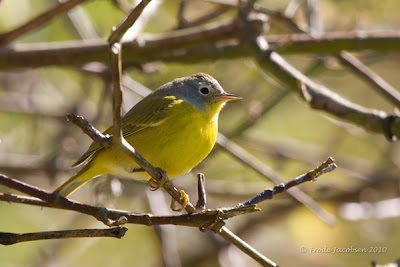Having an old farm right across the street was a major plus when we moved into our new neighborhood two years ago. My daily dog walks past the corn and hay fields in the morning yielded Blue Grosbeaks, Indigo Buntings, Orchard Orioles, American Pipits, Eastern Meadowlarks, flocks of Canada Geese, Killdeer, American Kestrels, Northern Harriers and other hawks hunting the fields. It was with great sorrow that we soon learned that the farm property has been sold and approved for light industrial development. A year and a half went by without anything happening, so we hoped that plans had been scrapped due to the poor economy. Alas, last winter bulldozers came and tore the farm house and the old barn down. However, nothing more has happened since. New crops were not sown last spring and the fields were left fallow all summer.
Ironically, the property is now in a more bird-friendly state than ever! Last Saturday I therefore decided to check it out, since the current owner probably doesn't care. The fields were overgrown with waist-deep weeds and grasses and hopping with sparrows! I zig-zagged across every field flushing birds in all directions and walked along all the hedgerows between the fields and along the forest edges. Best birds found were 1-2 Vesper Sparrow, 3 White-crowned Sparrow, 16 Savannah Sparrow, 2 Palm Warblers, and a beautiful Blue-headed Vireo.
Eastern (yellow) Palm Warbler
Immature White-crowned Sparrow
American Kestrel
The sparrows and grasshoppers had also attracted the attention of several Kestrels and a Merlin. Being a warm sunny day with a NW breeze also meant a strong hawk flight overhead, with numerous vultures, Red-tailed, Red-shouldered, Cooper's, and Sharp-shinned Hawks, a late Osprey and a Northern Harrier streaming south.
Turkey Vulture
Black Vulture
Adult Red-tailed Hawk
Adult Red-shouldered Hawk
Adult Cooper's Hawk
Immature Sharp-shinned Hawk
I will keep birding the area for all it's worth for as long as I can until they start digging and the inevitable fences and No Trespassing signs come up....... Sad!




































.jpg)






